
The River Axe is a 22-mile (35 km) long river in the counties of Dorset, Somerset and Devon, in the south-west of England. It rises in Dorset and flows south to Lyme Bay which it enters through the Axe Estuary in Devon. It is a shallow, non-navigable river, although its mouth at Seaton has some boating activity. The name Axe derives from a Common Brittonic word meaning "abounding in fish", and is cognate with pysg, the Welsh word for fish.
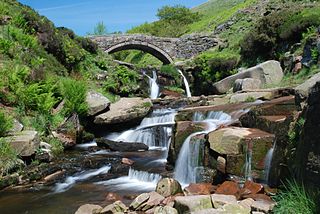
The River Dane is a tributary of the River Weaver that originates in the Peak District area of England. The name of the river is probably from the Old Welsh dafn, meaning a "drop or trickle", implying a slow-moving river.
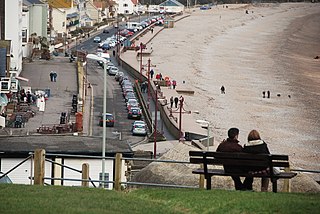
Seaton is a seaside town, fishing harbour and civil parish in East Devon on the south coast of England, between Axmouth and Beer. It faces onto Lyme Bay and is on the Jurassic Coast, a World Heritage Site. A sea wall provides access to the mostly shingle beach stretching for about a mile, and a small harbour on the River Axe estuary.

Baslow is a village in Derbyshire, England, in the Peak District, situated between Sheffield and Bakewell, just over 1 mile (1.6 km) north of Chatsworth House. It is sited by the River Derwent, which is spanned by a 17th-century bridge, alongside which is a contemporary toll house.

The River Coquet runs through the county of Northumberland, England, discharging into the North Sea on the east coast at Amble. It rises in the Cheviot Hills on the border between England and Scotland, and follows a winding course across the landscape ("Coquetdale"). The upper reaches are bordered by the Otterburn Ranges military training ground, and are crossed by a number of bridges built in the 20th century. It passes a number of small villages and hamlets, and feeds one of the lakes created by extraction of gravel that form the Caistron Nature Reserve, before reaching the town of Rothbury, where it is crossed by a grade II listed bridge. Below the town is Thrum Mill, the restoration of which was featured on Channel 4 television.

Piercebridge is a village and civil parish in the borough of Darlington and the ceremonial county of Durham, England. The population of the civil parish as of the 2011 census was 113. It is situated a few miles west of the town of Darlington. It is on the site of a Roman fort of AD 260–270, which was built at the point where Dere Street crossed the River Tees. Part of the fort is under the village green. The village is sited where the York-Newstead Roman road known as Dere Street crosses the River Tees.

Concrete bridges are a type of bridge, constructed out of concrete. They started to appear widely in the early 20th century.

The Seaton Tramway is a 2 ft 9 in narrow gauge electric tramway in the East Devon district of South West England. The 3-mile (4.8 km) route runs alongside the Axe Estuary and the River Coly, running between the coastal resort of Seaton, the village of Colyford, and the ancient town of Colyton. For much of its route, it operates between the estuary and the Seaton Wetlands nature reserves, offering views of the wildlife of both.

Berwick Bridge, also known as the Old Bridge, spans the River Tweed in Berwick-upon-Tweed, Northumberland, England. The current structure is a Grade I listed stone bridge built between 1611 and 1624.

Axmouth is a village, civil parish and former manor in the East Devon district of Devon, England, near the mouth of the River Axe. The village itself is about 1 mile (1.6 km) inland, on the east bank of the Axe estuary. The parish extends along the estuary to the sea, and a significant distance to the east. The village is near Seaton and Beer which are on the other side of the Axe estuary.

Hawkesdown Hill, also known as Hawkesdown Camp, is an Iron Age Hill fort close to Axmouth in Devon. It is situated on a prominent hillside above the Axe Estuary and is approximately 130 metres (430 ft) above sea level.

The Seaton branch line was a railway branch line connecting the seaside resort of Seaton, in the English county of Devon, to the main line network at Seaton Junction railway station, on the main line between Salisbury and Exeter.

The A3071 is a minor 'A' road in the English county of Cornwall, which links St Just to Penzance and the A30. It is 6.2 miles long.

The Wye Bridge in Monmouth is a bridge across the River Wye. The A466 passes over it and immediately meets the A40 at its western end. The bridge is a grade II listed building. The total span of the bridge is 71 metres (233 ft).
Philip Brannon was an artist, engraver, writer, printer, architect and civil engineer. In the 1850s he wrote and illustrated various guidebooks to Southampton, Bournemouth and other south coast places. He designed the Church of the Saviour in Southampton (1859), and the concrete Axmouth Old Bridge (1877) which pioneered the use of the material. He was granted patents relating to the use of concrete in building design, and also for “navigable balloons”, of which he was a keen advocate.
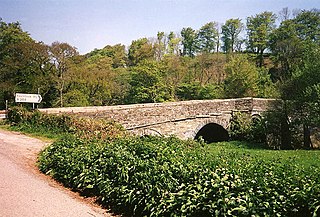
Greystone Bridge is a four-arch Grade I listed bridge over the River Tamar south-east of Launceston, Cornwall. It was built in 1439 and repaired in November 2007.

Cressbrook Dale is a dry carboniferous limestone gorge near Bakewell, Derbyshire, in the Peak District of England. The dale is cut into a plateau of farmland and lies to the south east of the village of Litton. Cressbrook village is at the foot of the valley to the south.

Ribchester Bridge is a toll-free, three-span bridge over the River Ribble near Ribchester, Lancashire, England. A Grade II listed structure, located about 0.75 miles (1.21 km) east of the village, it actually crosses the river between the civil parishes of Clayton-le-Dale and Dutton. The bridge carries the two-lane traffic of the B6245 Ribchester Road.
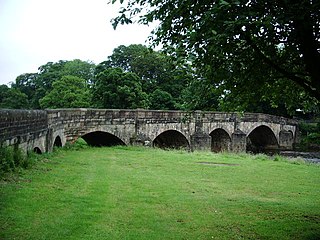
Edisford Bridge is a toll-free, nine-span bridge over the River Ribble near Clitheroe, Lancashire, England. A Grade II listed structure and a Scheduled monument, located about a mile WSW of the centre of town, it crosses the river to the civil parish of Great Mitton. The bridge carries the two-lane traffic of the B6243 Edisford Road.
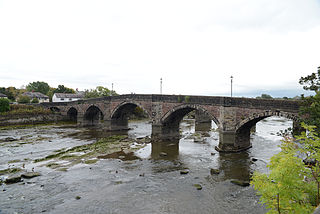
Penwortham Old Bridge is a toll-free, five-span bridge over the River Ribble at Preston, Lancashire, England. A Grade II listed structure and a scheduled monument, located about a mile southwest of the centre of the city, it crosses the river to Penwortham. Today the bridge no longer carries motorised traffic.

























